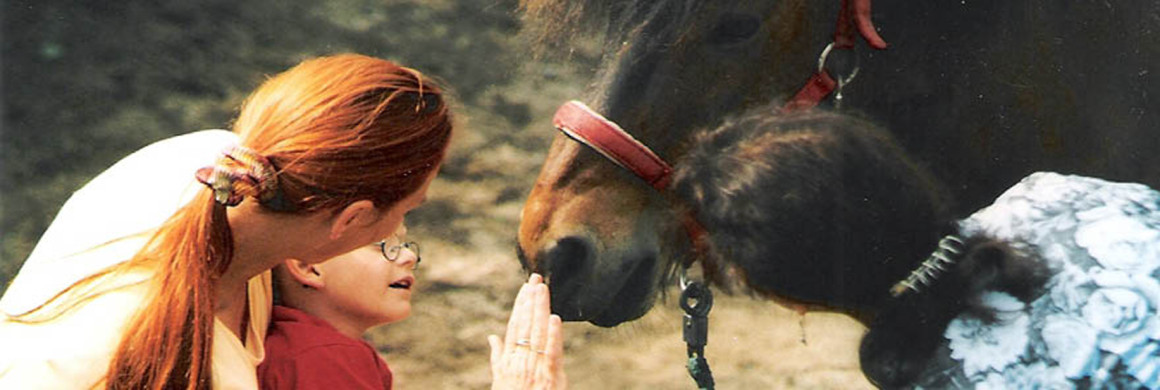The following post has been provided by one of our guest authors, Daniel Matthews.
You may know someone who has a therapeutic animal. In my experience as a Community-Based Rehabilitation Specialist, I’ve seen dogs, birds, and even hamsters fulfill the ‘therapeutic animal’ role. The animal serves as a companion allowing the individual to take her or his mind off of real, or perceived, problems. The animal helps teach care and empathy for another being. By helping ease and stabilize the mind, caring for the animal becomes a form of self-care for the individual.
Now, horses are emerging from the paddock as a quintessential and effective therapeutic animal. The physical and emotional impact of interacting with horses in a variety of ways can help treat physiological disorders, such as cerebral palsy, and psychological disorders, such as Post-Traumatic Stress Disorder. It turns out horses are particularly adept at helping us humans. And this makes sense. For ages the horse was man’s biggest helper, in the field and in front of the wagon. We’ve benefitted from harnessing the power of these animals in agriculture, transportation, building, and exploration.
But horses are proving to be indispensable aids in a way we haven’t thought about much until now. The following are reasons why equine-assisted therapy helps those in need of help.
Horses mirror humans
In a fascinating article for The Guardian, Joshua Thaisen documents the story of Sarah Smith. Sarah made a complete turnaround with her life after being psychologically and sexually abused for eighteen years. She went from a life on the streets to being close to graduating from Cal-State Long Beach with a 4.0 GPA. Equine-assisted therapy was the key to her achievement.
We’ve known for a long time that horses sense fear. Inversely, they sense calm. Horses are herd animals used to taking in slight adjustments in mood from others in the herd. When they are interacting with humans, Thaisen tells us they are actually able to synchronize their heartbeats to ours—they can hear your heart beat from four feet away. This allows therapists to gauge a patient’s emotional state by observing the horse. In Sarah Smith’s case, a pony mirrored her feelings centered on a particular object—a parachute. When Sarah observed the horse’s reaction to the parachute, it helped her face her feelings revolving around past trauma.
Horses help with mindfulness
This could also be said of dogs, but horses have their own unique claim to helping with mindfulness. In Sarah’s story I discussed above, the therapist had her close her eyes and feel all over the horse with her hands. Sarah brought no expectations to this exercise—it put her in a state of mindfulness, in which she took in the sensory impressions, the texture, the feel of the horse, without making a ‘good’ or ‘bad’ judgment of the impressions. The horse took Sarah out of her familiarity zone as no other animal can. And, when Sarah was distraught, the horse was mindful of her emotion, the horse was there with her in that emotion without passing judgment.
An equine-assisted therapy program for veterans diagnosed with PTSD teaches the vets to cope with their anxiety by teaching them how to interact with the horses. By simply being there with the horses, by learning how to treat them, feed them, and ride them, the vets experience a sense of calm one of them describes as an “in the moment” feeling. Simply riding the horse and feeling its movements beneath you encourages a state of mindfulness. There’s not a lot else you can think about when over a thousand pounds of flesh, muscle, blood, and bone are in your charge.
Horses are great physical therapists
In addition to the psychosocial benefits people diagnosed with mental illness experience, working with horses can also benefit physically impaired individuals. According to PsychCentral, 64% of people showed positive outcomes, both psychologically and physically, from working with horses. The physical benefits stem from the body’s need to adjust to the movement of the horse when riding.
This adjustment uses muscles important for walking and moving arms and torso (gross motor skills), as well as writing and speaking sign language (fine motor skills). Riding a horse at a walking gait assists with restoring the body’s balance, coordination, and confidence, which can be especially beneficial for people with autism and cerebral palsy. Continuing the activity allows the brain to rebuild neural pathways that direct the body to move the way it should move. Saying words like “whoah” and “walk on” to the horse helps the speech-impaired practice articulation.
We help ourselves
One of the major benefits of equine-assisted therapy is improved mood. The most effective forms of therapy allow the brain and body to heal through natural restorative processes. In other words, we do therapy on ourselves when we focus on a positive influence. The improved mood of patients is a signal that they are giving cells of the brain and body the chance to operate on a healthy level.
Did you ever sprain your ankle when playing sports as a child? There’s a reason why the coach told you to walk it off. The same applies to equine-assisted therapy.



As an equine reiki practitioner, I have seen first hand how horses can bring about a healing transformation in people. I’m usually there to assist the horse on their healing journey but many times I have felt the love they send back, and with other people, especially those who have some issues going on. The horses just seem to sense this and gravitate to them.